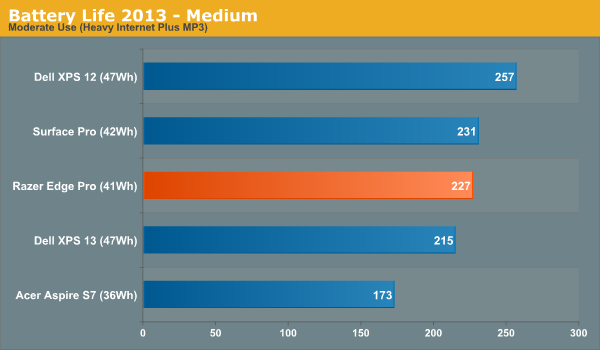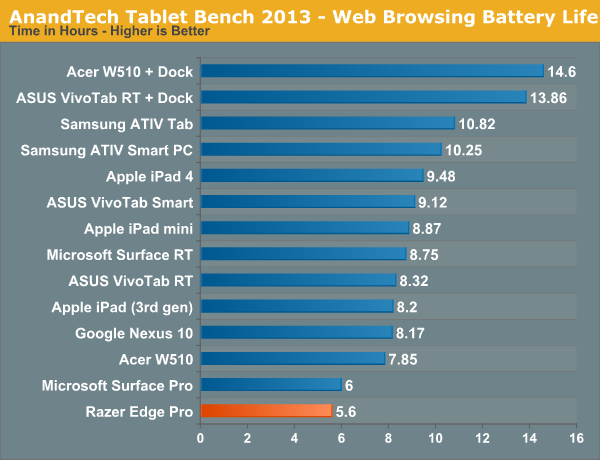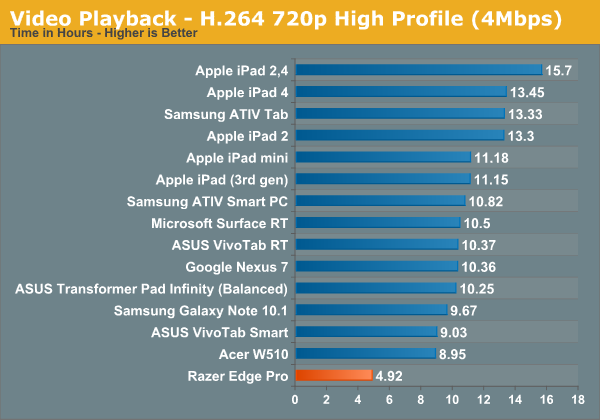The Razer Edge Review
by Vivek Gowri on March 28, 2013 11:00 AM EST- Posted in
- Tablets
- Mobile
- Razer
- Razer Edge
Battery Life and Mobile Gaming
This is the section that probably will garner the most scrutiny. The Edge comes with a 41.44Wh battery, and in normal usage situations, it does about as well as one could expect from an Ivy Bridge-based tablet. Surface Pro comes with a similarly sized battery, and we saw pretty similar runtime from the two tablets (Surface Pro, on average, had about 15-20 minutes more life in any given test). Considering that IVB ultrabooks don’t fare too much better (or, in some cases, significantly worse – looking at you Acer) I guess it’s hard to complain here; until we see Haswell and its significant idle power reduction later this year, ARM and Clovertrail tablets are going to slaughter IVB tablets in this category.




There’s an additional wrinkle with the Edge – the mobile gaming aspect. I broke down the typical gaming power draw in the introduction, and it’s worth bringing back up: pair a 17W CPU and a 20W GPU, consider that almost no reasonable workload will peg both at the same time, toss in loads for the display, SSD, RAM, WiFi, chipset, and all the other auxiliary components, and a 40W total system draw estimate in gaming workflows is pretty reasonable. If you’re using the Edge in the gamepad controller with the extended battery, there’s a total of 82.88Wh of battery power onboard. This sets up a pretty simple equation to estimate the gaming battery life: 82.88Wh/40W = ? hours. Do the simple division, and you’re looking at a hair over two hours, which is where Razer’s “two hours of gaming battery life” claim comes from. (I had John Wilson, Razer’s VP of System Engineering, walk me through the math here, and he confirmed that 80 divided by 40 did in fact equal two.)
Naturally, a good amount of testing was in order, so I unplugged the Edge, went to a nearby coffee shop, and played Dirt 3 until the battery died. I did this multiple times in the interest of generating as much data as possible (I love my job.) I was initially planning on using a timedemo or looping a benchmark, but I thought it would be more fun to actually game on the Edge – I also needed some real world mobile gaming experiences, so it killed two birds with one stone.
I spent most of my time in Dirt 3 and Need For Speed: The Run. The latter isn’t part of our benchmark suite and it’s not the most recent NFS title (it was a holiday 2011 release), but the Cannonball Run-esque storyline intrigued me and I’ve been meaning to play through it for some time without ever getting the chance to do so. The Edge review just gave me the excuse I needed to get into it.
The two hour estimate is pretty fair, depending on brightness levels, power plan, and graphics settings I saw anywhere between 1:45 and 2:30 in the newer games. I also fired up Quake III: Arena for curiosity’s sake, to see how much less strenuous a 12 year old game would be, and got 3:12 of playing time out of it. It’s worth noting that I wasn’t hitting network at all, either, so that’s another thing to consider.
In the “Balanced” power plan and a brightness of 200nits (55%), playing Dirt 3 with medium settings at the native 1366x768 resolution, the Edge lasted for 136 minutes (2:16) before running out of juice. That’s pretty much in line with what we expected, and lowering the brightness can help extend that. I wouldn’t recommend high or ultra settings due to the additional power draw, while the Power Saver profile throttles the GPU far too aggressively for smooth gameplay even at medium settings. The Balanced power profile and medium settings made for a nice compromise in mobile use cases.










89 Comments
View All Comments
jeffkro - Friday, March 29, 2013 - link
I heard an interview with a game developer who started in PC gaming, forget which one. He said they pushed for the switch from PC to consules, tragic. Now he said their push is going to be from consules to mobile devices, even worse. These are sad days for PC gamers, and each step down to lower end hardware has cut the potential of gaming.perry1mm - Saturday, March 30, 2013 - link
I think a lot of people miss the point and just overlook the potential uses this offers for people that might travel a few weeks or even months out of the year and are on the go a lot.For work I spend a couple weeks in a hotel a year, travel to see family a week or two, and spend a few weekends away here or there, not to mention just driving around or spending time out and about sitting down someplace for an hour or two.
There is no way I'd haul around my gaming desktop, this is great for on the couch average use, docking on-the-go, and gaming when plugged while traveling.
BUT, I ended up getting the Sony Vaio Duo 11 two months ago and it does all of this stuff, has a backlit keyboard attached already, I got the extended battery on sale, and total I paid $1450 for mine with a promo + $100 credit since I got the Sony Card, plus 8500 points ($85 more dollars of Sony Rewards). So out-the-door around $1300 with the newer i7 3537u, 8GB RAM, 256GB SSD, and the HD 4000 has played 90% of the games at full resolution (1080p).
Not to mention the HDMI built in, VGA out, SD slot, 2 USB 3.0 slots, and numerous other features that make it much more handy in a laptop functionality (gaming) a lot with still being portable for touch use in tablet mode.
For the people that rip on these products as being overpriced...no. When an ARM tablet can cost $500-800 and an ultrabook $1000+, paying $200-500 more for this with the hardware you're getting, storage/SSD, and accessibility, it is NOT really that expensive.
Now if all you do is sit at home and play games for a few minutes on your phone when on-the-go, or you don't care about space and lugging around a large laptop...then maybe this isn't for you. But both the Edge and Vaio Duo for me were great fits, I just happened to be perfectly happy with the Duo as to not need the Edge.
Netscorer - Saturday, March 30, 2013 - link
Weight and battery life are killers for this product. Price is an issue but there are people willing to pay for the mobility and they would not mind paying extra for exclusivity too. But once you consider that you always (ALWAYS!) need to brace this tablet against something (be it a lap on a train or table at the coffee shop) and that even then you can get at most 2 hours on a freshly charged batteries, the appeal of this hybrid goes way down and frankly, you can do the same on a laptop with a good trackpad, costing much less and having more versatility in other functions. By the way, I was surprised that Vivek never mentioned how absence of the physical keyboard affected using this device. Microsoft did a piss poor job with the virtual keyboard that blocks 2/3 of the screen every time you bring it up and when something like this happens as you prepare to game, it would be a major nuisance.MobiusStrip - Monday, April 1, 2013 - link
Look at that idiotic glossy screen.Death666Angel - Monday, April 1, 2013 - link
It's definitely an interesting product. I don't need a portable gaming machine, so this isn't for me. But even if it were: no display output and the display resolution kill it for me. You may justify the resolution, but it is still not acceptable for me. I'd rather have smaller pixels so that non-native resolutions look better as well. This is a compromise I'm not willing to put up with (and yes, I know that higher resolution would also mean more power draw from the display at same brightness). Also, 11.6" would have been a better display size in my opinion, could have upped the battery package or reduced the thickness. And I personally still don't play FPS games with a gamepad (or many other types for that matter) so for many games I'd need the dock and a keyboard/mouse. All in all, I think I'm better off with sticking with my Ativ Pro for the few games I want to play when I'm on holidays. :DAs for the review: Well done. But I'd really like a comment on whether or not this tablet supports Optimus and the corresponding battery life. :)
IceStorm - Tuesday, April 2, 2013 - link
As an Edge Pro owner, I agree with what has been written in the review. I've been busy installing and playing games since it arrived yesterday. It is fun.I have tried the Surface Pro. The lower resolution of the Edge is not an issue. If anything, it makes it easier to select things when at the traditional desktop. The screen is quite nice, and I have a retina iPad and a Kindle Fire HD for comparison.
This is an early adopter product. It is not for everyone. Just like the first Blade, if you balk at the price it isn't for you. The Razer store sold out of the initial production run of the 256GB Edge Pro in less than five hours. There is a market for it.
seapeople - Sunday, April 7, 2013 - link
I can picture the scene now outside the Razer store. A bunch of happy gamers walking out to their Corolla's, stumbling over the curb as they are locked into an intense game of Half Life, while dozens of well dressed men in suits shake there head and sneer as they lament how much money these gamers are wasting on this platform. The men in suits then jump into their Ferrari 328 GTS's and cruise off into the sunset, waiting in tempered melancholy for the day when they, too, will have the means to afford a handheld gaming unit that will bring joy to their lives.0 adrian 0 - Wednesday, April 3, 2013 - link
.MajinBlayze - Tuesday, December 3, 2013 - link
In your review regarding the downgrade from the pro version:"You lose the 1080p display and Wacom digitizer"
according to the support page here: http://www.razersupport.com/gaming-systems/razer-e... "The Razer Edge is not Wacom or pressure sensitive compatible"